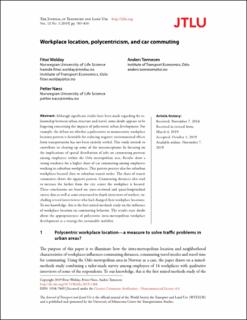| dc.contributor.author | Wolday, Fitwi | |
| dc.contributor.author | Næss, Petter | |
| dc.contributor.author | Tønnesen, Anders | |
| dc.coverage.spatial | Oslo, Norway | en_US |
| dc.date.accessioned | 2021-08-04T15:09:03Z | |
| dc.date.available | 2021-08-04T15:09:03Z | |
| dc.date.created | 2019-11-29T09:10:51Z | |
| dc.date.issued | 2019-11-11 | |
| dc.identifier.citation | Journal of Transport and Land Use. 2019, 12 (1), 785-810. | en_US |
| dc.identifier.issn | 1938-7849 | |
| dc.identifier.uri | https://hdl.handle.net/11250/2766254 | |
| dc.description.abstract | Although significant strides have been made regarding the relationship between urban structure and travel, some doubt appears to be lingering concerning the impacts of polycentric urban development. For example, the debate on whether a polycentric or monocentric workplace location pattern is favorable for reducing negative environmental effects from transportation has not been entirely settled. This study intends to contribute to clearing up some of the misconceptions by focusing on the implications of spatial distribution of jobs on commuting patterns among employees within the Oslo metropolitan area. Results show a strong tendency for a higher share of car commuting among employees working in suburban workplaces. This pattern persists also for suburban workplaces located close to suburban transit nodes. The share of transit commuters shows the opposite pattern. Commuting distances also tend to increase the farther from the city center the workplace is located. These conclusions are based on cross-sectional and quasi-longitudinal survey data as well as semi-structured in-depth interviews of workers, including several interviewees who had changed their workplace locations. To our knowledge, this is the first mixed-methods study on the influence of workplace location on commuting behavior. The results raise doubt about the appropriateness of polycentric intra-metropolitan workplace development as a strategy for sustainable mobility. | en_US |
| dc.language.iso | eng | en_US |
| dc.publisher | University of Minnesota, Libraries Publishing | en_US |
| dc.rights | Navngivelse-Ikkekommersiell 4.0 Internasjonal | * |
| dc.rights.uri | http://creativecommons.org/licenses/by-nc/4.0/deed.no | * |
| dc.title | Workplace location, polycentricism, and car commuting | en_US |
| dc.type | Peer reviewed | en_US |
| dc.type | Journal article | en_US |
| dc.rights.holder | © Copyright 2019 Fitwi Wolday, Petter Næss, Anders Tønnesen | en_US |
| dc.description.version | publishedVersion | en_US |
| cristin.unitcode | 7482,1,2,0 | |
| cristin.unitname | Byutvikling og bytransport | |
| cristin.ispublished | true | |
| cristin.fulltext | original | |
| cristin.qualitycode | 1 | |
| dc.identifier.doi | 10.5198/jtlu.2019.1488 | |
| dc.identifier.cristin | 1754229 | |
| dc.source.journal | Journal of Transport and Land Use | en_US |
| dc.source.volume | 12 | en_US |
| dc.source.issue | 1 | en_US |
| dc.source.pagenumber | 785-810 | en_US |
| dc.relation.project | Norges forskningsråd: 235859 | en_US |

